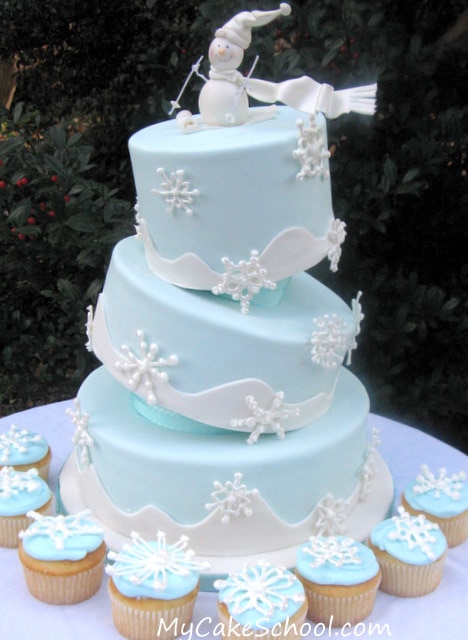Royal Icing Snowflakes for Cakes and Cupcakes
Today I'm going to demonstrate how to make beautiful royal icing snowflakes!

Table of Contents
Here's a quick tutorial on how to make snowflakes
As you can see, I like start with some sort of template---you can either draw some templates of your own, or print off some snowflake clip art. If you are feeling really adventurous, you can freehand them!
By the way, did you know that snowflakes have 6 points? I didn't know that when I made mine. So, if you want to be technical about it, just keep that in mind lol (Someone messaged me with this info, haha) ;0)

Once you have made your template, just slide it under a piece of parchment paper. Parchment really is better than waxed paper for royal icing decorations. It breathes better.

Next....we trace!
Make a batch of royal icing and thicken it with powdered sugar until you have reached a medium consistency (it needs to be able to hold it's shape, but not so thick that it is difficult to pipe with)-- I like to use a Wilton small round tip 3 or 4.
Word to the wise---Trace over your snow flakes a couple of times. This will make them stronger.

Aren't they pretty? I like piping dots onto the snowflakes for added texture and cuteness :0)

After about 24 hours or so, your royal icing snowflakes will be nice and dry. Once dry, they will not stick to the parchment at all. Simply (carefully) pick them up!
My favorite part of the snowflakes is pearlizing them and adding a little sparkle. This is an optional step--they are pretty as they are..but I love to dress them up a bit!
If you don't own an airbrush, the next best thing is using the PME pearl spray (or a similar product).
If you don't have this, the next best thing is brushing on some CK Super Pearl pearl dust with a dry brush. Instantly beautiful!
Candy Coating Alternative
*In a rush? You can also create snowflakes using white candy coating/bark coating. Pipe them onto a wax paper lined cookie sheet.
Then, chill them for a few minutes to firm up. Applying to the cake or cupcakes so that they will be less fragile and easier to handle.
"Glue " them onto buttercream cakes with a dot of buttercream, or fondant cakes with a little melted candy coating.


I recommend using royal icing decorations on fondant or a crusting buttercream.
Royal icing and moisture don't get along so well, so don't use with a whipped cream or non-crusting icing unless you are serving right away.
I attached the snowflakes to my tilted cake using just a little bit of royal icing as my glue. It adheres almost immediately.
I frosted these cupcakes and then let them sit for just a few minutes in order for them to crust. Then, I added our sweet snowflakes! Love them!
That's all for now, I hope you'll make some snowflakes for your sweets very soon! 

Where were you for my wedding last year!? GORGEOUS!
Pearl dust comes in a spray form now? How awesome! These look gorgeous!
Thank you!!
Adorable cake! Thanks for the snowflake tutorial, these look like fun to make!
LOVE this!!!! I have lots of Holiday cupcake orders, PERFECT!!
Can you please tell me how you made the snowman?
I am kkgoing to make snowflakes today to get ready for my Christmas baking.
I love your tutorials they are really helpful and these snowflakes are beautiful, im going to use them on my christmas cakes this year. Thanks
love the cakes & snowflakes. . . .how far b4 and event can i do the snowflakes, would the royal icing crack or anything like that if done say up to a week or 10 days b4?? and. . . your suggestion was not to use with a non-crusting icing, could i possibly use them with a cream cheese frosting if i added some butter to the icing??
Thanks! The royal icing snowflakes would be fine to do that far in advance. Lots of cream cheese frosting recipes call for butter also-- (or shortening) -- and often are pretty soft. I know that there are some crusting cream cheese frosting recipes out there--I know that there is one floating around on Cake Central. I would do a test run (just spread the icing in question on some parchment paper and place a snowflake or two on top). Ideally, the royal icing accents would be placed on the cake within a few hours of the party to be on the safe side.
Just to be picky, but I notice you have some 8-sided snowflakes and some other odd geometry. Snowflakes form as a result of the polarity of the water molecule, which is shaped rather like Mickey Mouse with the oxygen atom being the head (which has a slightly negative charge) and the two hydrogen atoms as the ears (which are slightly positive). Because opposites attract, water crystals form in such a way as to pack the positive ears around the negative heads of other water molecules, and the most space-efficient way to do this is a hexagonal arrangement. Branching in the snowflake occurs with changes in temperature as they're made in clouds, and since the base structure is hexagonal, all the branch points will emanate from a hexagonal base. Since snowflakes are hexagonal all the way down to a few Angstroms' scale, the six points will be perfectly spaced around a circle. Therefore, all snowflakes have hexagonal structures with secondary branches 60 degrees (1/6th of a circle) off the primary branches.
Fantastic! well done.
Ohh just a quick note to BakingIsChemistry regarding their comment -
Zzzzzzzzzzzzzzzzzzzzz get a life.